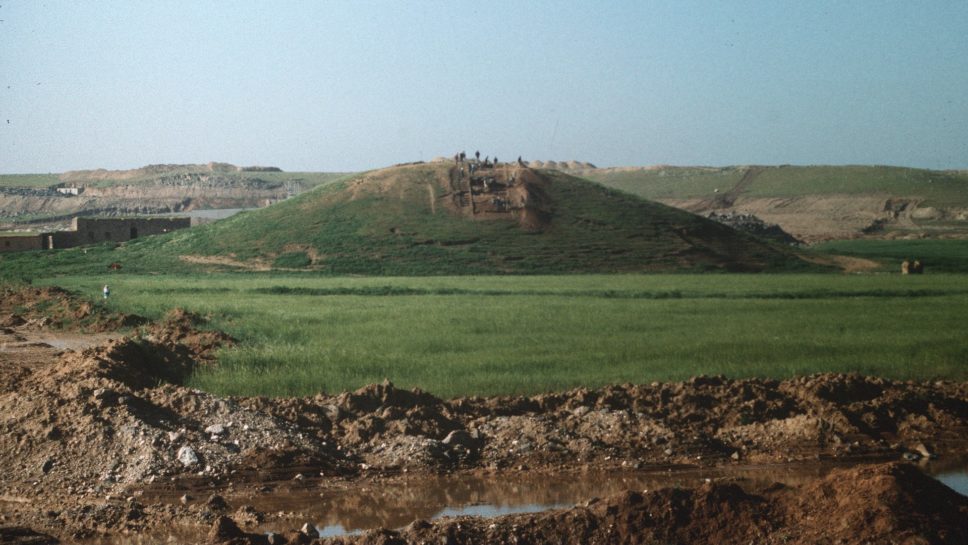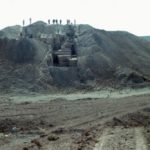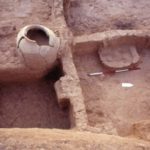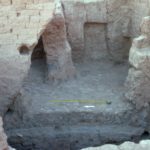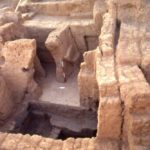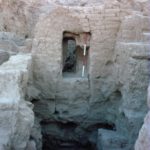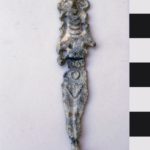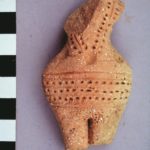Tell Djassa el-Gharbi
Tell Jassa (el-Gharbi)
Tell Jassas
-
Project name:
Western Hassake Dam Project
-
Site type:
Settlement site; (fortified?) rural settlement
Location:
Syria
Syrian Jazira, Upper Kahbur basin (so-called Khabur Triangle)
Upper MesopotamiaDating:
– Early Dynastic III period (2500–2300 BC)
– Hellenistic pottery fragments indicate that the site was resettled at the end of the 1st millennium BC
Most interesting finds:
– Well-preserved architectural remains
– Lead figurine of Ishtar(?)
History of research:
Dates of PCMA research:
1988–1990
Type of research:
Salvage excavations
Project directors:
Maria Krogulska (first season)
Piotr Bieliński
Partners:
– Polish Centre of Mediterranean Archaeology of the University of Warsaw
– Directorate of Antiquities of the Republic of Syria
Description of site and research results:
The steep, conical-shaped hill 16 m high and with surface of about 2 ha is located about 10 km to the north-west of the city of Hassake near Wadi Avedji (about 2.5 km to the south-east of Tell Abu Hafur, which was excavated as part of the same salvage project). At present it lies on the bank of an artificial water reservoir.
Four archaeological layers from the 3rd millennium BC were identified during salvage excavations. Rooms furnished with clay basins with walls lined with gypsum belonged to Layer I. In one of them 29 pottery vessels were found.
The best preserved remains were discovered in Layer II. Some of the mud-brick walls had been preserved to the height of 2.3 m. Parts of two presumably domestic buildings were also uncovered. Some of the rooms in the bigger one had ceilings made of two false arches resting on internal buttresses. The original height of the room is estimated to have been 4 m.
A massive mud-brick structure adjoining the domestic buildings on the edge of the tell also belonged to Layer II. It was a two-step platform about 4.60 m high and more than 10 m wide. It may have constituted a part of the fortifications surrounding the settlement.
Some of the pottery vessels from Tell Djassa were presented to Poland by the Iraqi government and are now part of the collection of the National Museum in Warsaw.
Bieliński, P. (2012). A lead “Ishtar”-type figurine from Tell Djassa el Gharbi, w: Quenet, P., M. Al-Maqdissi, (eds.): “L’heure Immobile” entre ciel et terre. Melanges en l’honneur d’Antoine Souleiman (pp. 5–8). Turhout: Brepols, SUBARTU.
Smogorzewska, A. (2010). Technological marks on pottery vessels. Study of evidence from Tell Arbid, Tell Rad Shaqrah and Tell Jassa el-Gharbi (Northeastern Syria), Polish Archaeology in the Mediterranean, 19, 555–564.
Bieliński, P. (2005). Arcaded houses from Tell Djassa El Gharbi and Tell Rad Shaqrah. Aux pays dAllat. Melanges offerts a M. Gawlikowski. Warszawa, 31–42.
Reiche, A. (2001). Polish archaeological research in Northeastern Syria. Bulletin du Musée National de Varsovie, 42, 95–106.
Bieliński, P. (1995). Od Eufratu do Tygrysu i jeszcze dalej, w: M. L. Bernhard (red.), Od Nilu do Eufratu: polska archeologia śródziemnomorska 1981–1994 (pp. 119–126). Warsaw: PCMA.
Bieliński, P. (1991). The third season of excavations in Northeastern Syria – 1990. Polish Archaeology in the Mediterranean, 2, 94–101.
Bieliński, P. (1990). Polish excavations in Northeast Syria 1988–1989. Polish Archaeology in the Mediterranean, 1, 17–25.
Bieliński, P. et alii (1989). Hasake, Tell Djassa Al-Gharbi, Tell Abu Hafur, Informator Archeologiczny: badania, 23, 105
Krogulska, M. et alii (1988). Tell Djassa Al-Gharbi, Tell Abu Hafur, Informator Archeologiczny: badania, 22, 158–159.
Gallery:
-
1. Tell Djassa al-Gharbi, panorama of the site. Tell Djassa el-Gharbi, panorama stanowiska.
-
2. Trench on the northern slope of the tell. Brick structures from the mid-3rd millennium BC visible. Wykop na stoku północnym tellu. Odsłonięte konstrukcje ceglane z połowy 3 tysiąclecia p.n.e.
-
3. Rooms from Layer I with basins of unknown purpose. Pomieszczenia warstwy I z instalacjami w postaci baseników o nieznanym przeznaczeniu.
-
4. Room from Layer II with false arches resting on buttresses which supported the ceiling. Pomieszczenie warstwy II z fałszywymi łukami na przyporach podtrzymujących sklepienie.
-
5. View of the remains from Layer II dated to the Early Dynastic period (3rd millennium BC). Widok na pozostałości warstwy II z okresu wczesnodynastycznego (3 tysiąclecie p.n.e.).
-
6. Remains from Layer II; entrance preserved in one of the walls. Pozostałości warstwy II; zachowany otwór drzwiowy w jednej ze ścian.
-
7. Lead plaque with the depiction of a naked woman, possibly the goddess Ishtar(?); height 6.8 cm. Ołowiana plakietka z przedstawieniem nagiej kobiety, być może bogini Isztar(?); wysokość 6,8 cm. (fot. A. Reiche)
-
8. Terracotta female figurine. Terakotowa figurka kobieca.
-
9. Plan of the site on Tell Djassa al-Gharbi. Plan stanowiska Tell Djassa el-Gharbi.

